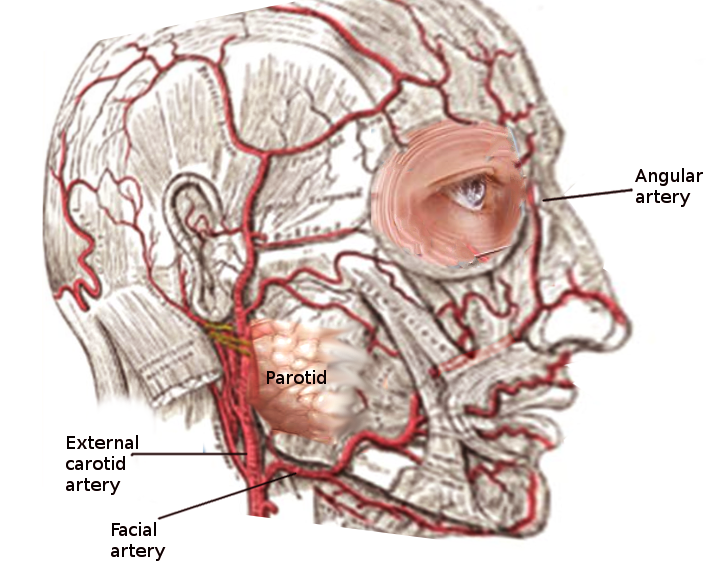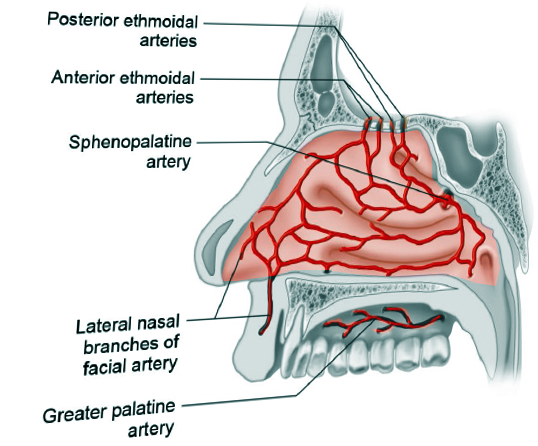[1]
Rohrich RJ, Gunter JP, Friedman RM. Nasal tip blood supply: an anatomic study validating the safety of the transcolumellar incision in rhinoplasty. Plastic and reconstructive surgery. 1995 Apr:95(5):795-9; discussion 800-1
[PubMed PMID: 7708862]
[2]
Pilsl U, Anderhuber F. The External Nose: The Nasal Arteries and Their Course in Relation to the Nasolabial Fold and Groove. Plastic and reconstructive surgery. 2016 Nov:138(5):830e-835e. doi: 10.1097/PRS.0000000000002626. Epub
[PubMed PMID: 27782991]
[3]
MacArthur FJ, McGarry GW. The arterial supply of the nasal cavity. European archives of oto-rhino-laryngology : official journal of the European Federation of Oto-Rhino-Laryngological Societies (EUFOS) : affiliated with the German Society for Oto-Rhino-Laryngology - Head and Neck Surgery. 2017 Feb:274(2):809-815. doi: 10.1007/s00405-016-4281-1. Epub 2016 Aug 27
[PubMed PMID: 27568352]
[4]
Lombardo GA, Tamburino S, Tracia L, Tarico MS, Perrotta RE. Lateral Nasal Artery Perforator Flaps: Anatomic Study and Clinical Applications. Archives of plastic surgery. 2016 Jan:43(1):77-83. doi: 10.5999/aps.2016.43.1.77. Epub 2016 Jan 15
[PubMed PMID: 26848450]
[5]
Prades JM, Asanau A, Timoshenko AP, Faye MB, Martin Ch. Surgical anatomy of the sphenopalatine foramen and its arterial content. Surgical and radiologic anatomy : SRA. 2008 Oct:30(7):583-7. doi: 10.1007/s00276-008-0390-x. Epub 2008 Jul 23
[PubMed PMID: 18648719]
[6]
El-Shaarawy EAA, Hassan SS. The sphenopalatine foramen in man: anatomical, radiological and endoscopic study. Folia morphologica. 2018:77(2):345-355. doi: 10.5603/FM.a2017.0104. Epub 2017 Nov 13
[PubMed PMID: 29131280]
[9]
Moore K 2nd, Thompson R, Lian T. The pedicled levator labii superioris alaeque nasi flap: A durable single-stage option for reconstruction of full-thickness nasal defects. American journal of otolaryngology. 2019 Mar-Apr:40(2):279-281. doi: 10.1016/j.amjoto.2018.09.015. Epub 2018 Oct 2
[PubMed PMID: 30473167]
[10]
Jung DH, Kim HJ, Koh KS, Oh CS, Kim KS, Yoon JH, Chung IH. Arterial supply of the nasal tip in Asians. The Laryngoscope. 2000 Feb:110(2 Pt 1):308-11
[PubMed PMID: 10680935]
[11]
Lee W, Kim JS, Oh W, Koh IS, Yang EJ. Nasal dorsum augmentation using soft tissue filler injection. Journal of cosmetic dermatology. 2019 Oct:18(5):1254-1260. doi: 10.1111/jocd.13018. Epub 2019 Jun 3
[PubMed PMID: 31157508]
[12]
Zimman OA, Felice F. The lateral nasal artery pedicle nasolabial island flap. Plastic and reconstructive surgery. 2008 Jun:121(6):2177. doi: 10.1097/PRS.0b013e31817072fe. Epub
[PubMed PMID: 18520919]
[13]
Jang SY, Kim WS, Kim HK, Bae TH. Nasal Columellar Reconstruction With Reverse Lateral Nasal Artery Pedicled Nasolabial Island Flap. The Journal of craniofacial surgery. 2018 May:29(3):e250-e251. doi: 10.1097/SCS.0000000000004268. Epub
[PubMed PMID: 29381622]
[14]
Aynehchi BB, Westreich RW. Lateral nasal artery pedicled island flap for repair of nasal alar defects. Otolaryngology--head and neck surgery : official journal of American Academy of Otolaryngology-Head and Neck Surgery. 2012 Mar:146(3):382-4. doi: 10.1177/0194599811428036. Epub 2011 Nov 7
[PubMed PMID: 22063733]
[15]
Murakami CS, Kriet JD, Ierokomos AP. Nasal reconstruction using the inferior turbinate mucosal flap. Archives of facial plastic surgery. 1999 Apr-Jun:1(2):97-100
[PubMed PMID: 10937085]
[16]
Gil Z, Margalit N. Anteriorly based inferior turbinate flap for endoscopic skull base reconstruction. Otolaryngology--head and neck surgery : official journal of American Academy of Otolaryngology-Head and Neck Surgery. 2012 May:146(5):842-7. doi: 10.1177/0194599811434516. Epub 2012 Jan 18
[PubMed PMID: 22261494]
[17]
Fortes FS,Carrau RL,Snyderman CH,Prevedello D,Vescan A,Mintz A,Gardner P,Kassam AB, The posterior pedicle inferior turbinate flap: a new vascularized flap for skull base reconstruction. The Laryngoscope. 2007 Aug
[PubMed PMID: 17597634]
[18]
Koziej M, Trybus M, Hołda M, Polak J, Wnuk J, Brzegowy P, Popiela T, Walocha J, Chrapusta A. Anatomical Map of the Facial Artery for Facial Reconstruction and Aesthetic Procedures. Aesthetic surgery journal. 2019 Oct 15:39(11):1151-1162. doi: 10.1093/asj/sjz028. Epub
[PubMed PMID: 30721996]


